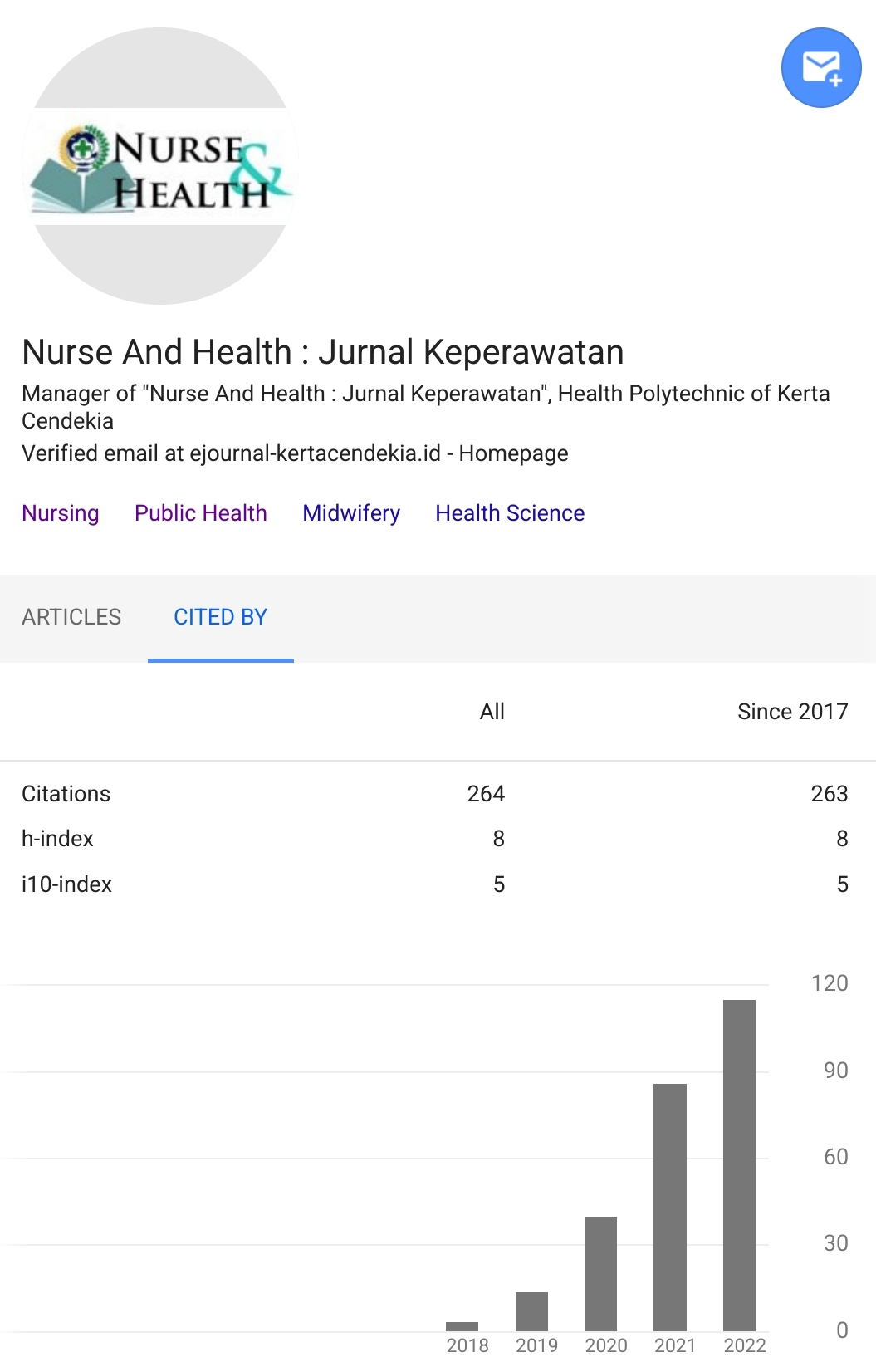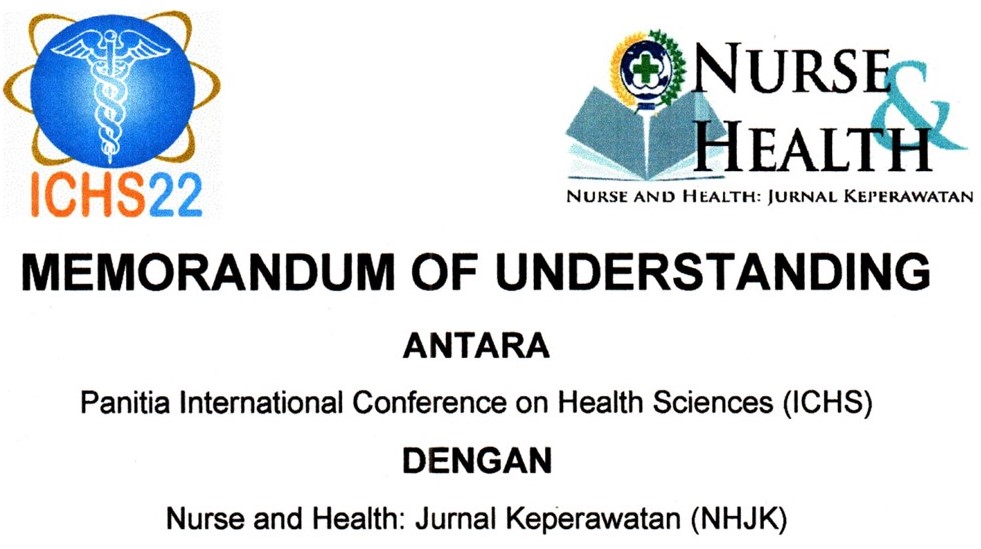APPLICATION OF FAMILY CENTERED CARE (FCC)
Abstract
The role of the family in the theoretical system is as a caregiver for sick family members. Family involvement in client care is applied in care known as the Family Centered Care concept. The application of Family Centered Care can increase knowledge and attitudes of families in the care of clients who are hospitalized. The purpose of the study was to determine the level of application of Family Centered Care. The research method used is a descriptive study. The research sample was 100 respondents. The sampling technique used is accidental sampling. The data collection tool used is a family centered care questionnaire. The research analysis used univariate analysis in the form of a frequency distribution. The results showed that the application of family centered care was in the good category as many as 71 respondents (71%), and in the medium category as many as 29 respondents (29%). From the results of the study, it was stated that nurses had involved the family in care, where the family participated in making decisions on support plans, recovery and helping patients not to be anxious. The conclusion is that the application of family centered care is in the good category.Downloads
References
Buus-Frank, M.E. (2011). Principles and practices of family centered care and the late preterm infant. Dynamic Neonatal Solutions. Updated Fall 2011
Creasy, R, L., Lutz, J, B., Young, E, M., Ford, A., & Martz, C. (2014). The impact of interactions with providers on stroke caregivers’ needs. Rehabil Nurs, 38, 88-98 DOI: https://doi.org/10.1002/rnj.69
Family voice. (2008). Family centered care self-assessment tool. Diperoleh tanggal 20 Agustus 2019 dari www.familyvoices.org/...family_centered/.../fcca_...
Friedman, M.M. (2010).Keperawatan Keluarga. Jakarta: PenerbitBuku Kedokteran
Lutz, B.J., Young, M.E., Cox, K.J., Martz, C., & Creasy, K.R. (2011). The crisis of stroke: Experiences of patients and their family caregivers. Topics in Stroke Rehabilitation, 18(6), 786–797. DOI: https://doi.org/10.1310/tsr1806-786
NANDA. (2012). Nursing Diagnoses: Definitions and Classification 2012-2014. Jakarta: EGC Medical Publisher.
Polit, D.F., & Beck, C.T. (2008). Nursing research: Generating and assessing evidence for nursing practice (8th Ed.). Philadelphia: Lippincott
Robinson. (1995). Unifying distinctions for nursing research with persons and family. Journalof Advanced Nursing ,8-29. DOI: https://doi.org/10.1177/107484079500100102
Shelton, TL., Jeppson, ES., Johnson, BH. (1987). Family centered care for children with special health care needs. Washington, DC: Association for the Care of Children’s Health
Shenton, A.K. (2004). Strategies for ensuring trustworthiness in qualitative research projects. Journal of Education for Information, 22, 63-75. DOI: https://doi.org/10.3233/EFI-2004-22201
Sudiharto. (2005). Asuhan Keperawatan Keluarga dengan Pendekatan Keperawatan Transkultural.Jakarta:PenerbitBuku Kedokteran,EGC.
Sunarti, E. (2008). Program Pemberdayaan dan Konseling Keluarga. Bogor: Fakultas Ekologi Manusia IPB.
Wright, L., & Leahey, M. (2000). Nurses and families: A guide in family assesment and intervention. Philadelphia: Davis.
Ozyazıcıoglu.(2018). Determination of Pediatric Nurses’ Attitudes on Family-Centered Care. International Journal of Caring Sciences
Natasya, et al. (2019). Gambaran Penerapan Pemberian Informasi Berdasarkan Konsep Family Centered Care Pada Anak Dengan Penyakit Akut. JOM FKp, Vol. 6 No.1 (Januari-Juni) 2019
Sari, E. I. (2017). Gambaran perawat dalam melakukan orientasi pasien baru di instalasi rawat inap rsud hj. anna lasmanah banjarnegara. Fakultas Kedokteran Universitas Diponegoro. Diperoleh tanggal 12 April 2021 dari http://eprints.undip.ac.id
Nurlaila. (2015). Studi eksplorasi perawatan berpusat pada keluarga di ruang peristi rsud kebumen. Jurnal ilmiah kesehatan keperawatan, 11(3). http://ejournal.stikesmuhgombong.ac.id DOI: https://doi.org/10.26753/jikk.v11i3.114
Copyright (c) 2023 Ratnasari -, Dwi Fitriyanti

This work is licensed under a Creative Commons Attribution-NonCommercial 4.0 International License.
Authors who publish with Nurse and Health: Jurnal Keperawatan agree to the following terms:
- Authors retain copyright licensed under a Creative Commons Attribution-NonCommercial 4.0 (CC BY-NC 4.0), which allows others to remix, tweak, and build upon the authors' work non-commercially, and although the others' new works must also acknowledge the authors and be non-commercial, they don't have to license their derivative works on the same terms.
- Authors are permitted and encouraged to post their work online (e.g., in institutional repositories or on their website) prior to and during the submission process, as it can lead to productive exchanges, as well as earlier and greater citation of published work (See The Effect of Open Access). Authors can archive pre-print and post-print or publisher's version/PDF.








_resize1.jpg)















